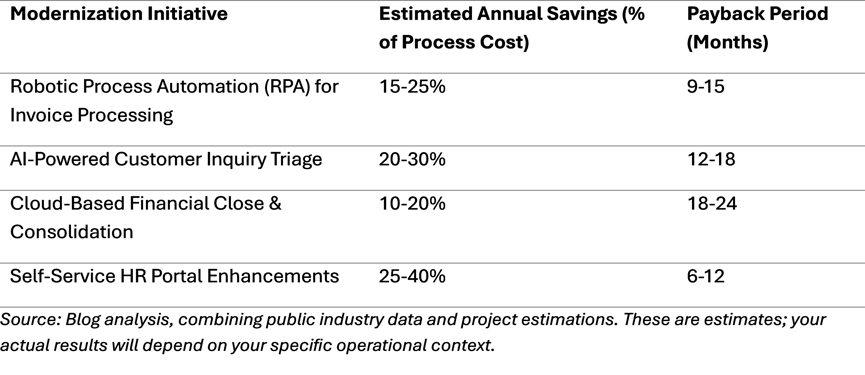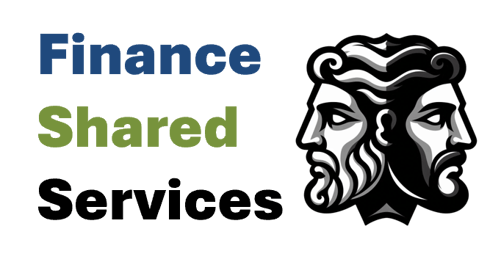Your CFO Wants to Cut Costs. You Need to Modernize. Here’s How to Do Both.
Your CFO is talking about austerity. Your team is struggling with legacy systems. You know that investing in process modernization is the only way to build a resilient and efficient shared services organization for the future.
The problem is, these two objectives seem to be in direct opposition. They are not. In a cost-cutting culture, strategic process modernization is not a discretionary expense; it is a direct path to sustainable savings. The key is to shift the conversation from "cost" to "investment with a clear return."
The New Reality: Efficiency is the Only Currency
The pressure to reduce operating expenses is a familiar story for shared services leaders. What feels different in 2025 is the lack of an obvious next move. You have already captured the savings from labor arbitrage. You have consolidated processes. Now, you must find savings in a more complex environment.
This is where a targeted approach to process modernization becomes your primary tool. Forget about massive, multi-year transformation projects that require nine-figure checks. The current climate demands a more surgical approach. The goal is to fund modernization by identifying and eliminating existing inefficiencies.
Estimated Savings from Targeted Modernization Initiatives


Top Trends: Where to Place Your Bets
You cannot afford to boil the ocean but you need to find a few big fish to fry in that ocean. You must be selective and focus on technologies that offer a clear and rapid return on investment.
Surgical Automation: The era of "automate everything" is over. It proved too costly and complex. The new focus is on identifying specific, high-volume, rules-based tasks within larger processes. Think invoice validation in accounts payable or employee data entry in HR. These smaller, targeted RPA and AI projects have shorter payback periods and generate immediate cost savings that can fund further modernization.
Process Mining as a Prerequisite: You cannot fix what you cannot see. Before you invest a single dollar in new technology, you need a clear, data-driven picture of how your processes actually run, not how you think they run. Process mining and discovery tools provide this visibility. They highlight bottlenecks, duplicate work, and deviations from standard procedure, allowing you to build a business case for modernization based on hard data. This shifts the conversation from a subjective request to a logical business decision.
Low-Code/No-Code Platforms: Your IT department is likely overwhelmed. Low-code and no-code application platforms empower your own process experts to build solutions. These platforms can be used to create simple workflows, data collection forms, and departmental dashboards. This reduces reliance on central IT resources, accelerates solution delivery, and puts the power of automation directly into the hands of the people who understand the processes best.
Acknowledge and Manage the Risks
A cost-cutting environment magnifies the risks of any new initiative. Be direct about these challenges and have a plan to mitigate them.
Change Fatigue: Your team is already under pressure. Do not frame modernization as another top-down mandate. Instead, position it as a way to eliminate their most frustrating and repetitive tasks. Involve them in the process of identifying and designing the solutions.
Pilot Purgatory: Many promising technology pilots die on the vine because there is no clear plan for scaling them. Before you start a pilot, define what success looks like and secure a commitment for enterprise-wide rollout if those metrics are met.
The Integration Trap: A new tool that does not talk to your existing systems creates more work, not less. Prioritize platforms with robust, pre-built APIs and connectors to your core ERP and other systems of record. A seamless data flow is not a feature; it is a requirement.
Future Outlook: The Self-Funding Transformation
The most successful shared services leaders in the next three to five years will be those who master the art of the self-funding modernization program. The model is straightforward:
Identify: Use process mining to find a high-cost, inefficient process.
Automate: Implement a targeted automation solution.
Harvest: Measure the cost savings from the initial project.
Re-invest: Use those savings to fund the next modernization initiative.
Wisdom To Action: This creates a virtuous cycle of continuous improvement. It demonstrates fiscal responsibility to your CFO while systematically building a more modern and effective shared services organization. This is how you win in a cost-cutting culture. You stop asking for money and start demonstrating how strategic investments in process modernization can pay for themselves.
